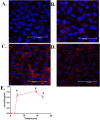Zonulin Regulates Intestinal Permeability and Facilitates Enteric Bacteria Permeation in Coronary Artery Disease
- PMID: 27353603
- PMCID: PMC4926221
- DOI: 10.1038/srep29142
Zonulin Regulates Intestinal Permeability and Facilitates Enteric Bacteria Permeation in Coronary Artery Disease
Abstract
Several studies have reported an association between enteric bacteria and atherosclerosis. Bacterial 16S ribosomal RNA (rRNA) gene belong to Enterobacteriaceae have been detected in atherosclerotic plaques. How intestinal bacteria go into blood is not known. Zonulin reversibly modulate intestinal permeability (IP), the circulating zonulin levels were increased in diabetes, obesity, all of which are risk factors for atherosclerosis. It is unclear whether the circulating zonulin levels were changed in coronary artery disease (CAD) patients and modulate IP. The 16S rRNA gene of bacteria in blood sample was checked by 454 pyrosequencing. The zonulin levels were determined by enzyme-linked immunosorbent assay (ELISA) methods. The distribution of zonulin was detected by confocal immunofluorescence microscopy. Bacteria and Caco-2 cell surface micro-structure were checked by transmission electron microscopy. A high diversity of bacterial 16S rRNA gene can be detected in samples from CAD patients, most of them (99.4%) belong to Enterobacteriaceaes, eg. Rahnella. The plasma zonulin levels were significantly higher in CAD patients. Pseudomonas fluorescens exposure significantly increased zonulin expression and decreased IP in a time dependent manner. The elevated zonulin increase IP and may facilitate enteric translocation by disassembling the tight junctions, which might explain the observed high diversity of bacterial 16S rRNA genes in blood samples.
Figures





Similar articles
-
Gut microbiota, dietary intakes and intestinal permeability reflected by serum zonulin in women.Eur J Nutr. 2018 Dec;57(8):2985-2997. doi: 10.1007/s00394-018-1784-0. Epub 2018 Jul 24. Eur J Nutr. 2018. PMID: 30043185 Free PMC article.
-
Gut Microbiota Richness and Composition and Dietary Intake of Overweight Pregnant Women Are Related to Serum Zonulin Concentration, a Marker for Intestinal Permeability.J Nutr. 2016 Sep;146(9):1694-700. doi: 10.3945/jn.116.235358. Epub 2016 Jul 27. J Nutr. 2016. PMID: 27466607
-
Zonulin level, a marker of intestinal permeability, is increased in association with liver enzymes in young adolescents.Clin Chim Acta. 2018 Jun;481:218-224. doi: 10.1016/j.cca.2018.03.005. Epub 2018 Mar 12. Clin Chim Acta. 2018. PMID: 29544751
-
Zonulin, a regulator of epithelial and endothelial barrier functions, and its involvement in chronic inflammatory diseases.Tissue Barriers. 2016 Oct 21;4(4):e1251384. doi: 10.1080/21688370.2016.1251384. eCollection 2016. Tissue Barriers. 2016. PMID: 28123927 Free PMC article. Review.
-
Advances in the role and mechanism of zonulin pathway in kidney diseases.Int Urol Nephrol. 2021 Oct;53(10):2081-2088. doi: 10.1007/s11255-020-02756-9. Epub 2021 Jan 11. Int Urol Nephrol. 2021. PMID: 33428167 Review.
Cited by
-
The Hazards of Probiotics on Gut-Derived Pseudomonas aeruginosa Sepsis in Mice Undergoing Chemotherapy.Biomedicines. 2024 Jan 23;12(2):253. doi: 10.3390/biomedicines12020253. Biomedicines. 2024. PMID: 38397855 Free PMC article.
-
Loss of Gut Barrier Integrity In Lupus.Front Immunol. 2022 Jun 20;13:919792. doi: 10.3389/fimmu.2022.919792. eCollection 2022. Front Immunol. 2022. PMID: 35795671 Free PMC article. Review.
-
Fluctuation of zonulin levels in blood vs stability of antibodies.World J Gastroenterol. 2017 Aug 21;23(31):5669-5679. doi: 10.3748/wjg.v23.i31.5669. World J Gastroenterol. 2017. PMID: 28883692 Free PMC article.
-
A mechanism by which gut microbiota elevates permeability and inflammation in obese/diabetic mice and human gut.Gut. 2023 Oct;72(10):1848-1865. doi: 10.1136/gutjnl-2022-327365. Epub 2023 Mar 22. Gut. 2023. PMID: 36948576 Free PMC article.
-
Intestinal barrier dysfunction as a therapeutic target for cardiovascular disease.Am J Physiol Heart Circ Physiol. 2020 Dec 1;319(6):H1227-H1233. doi: 10.1152/ajpheart.00612.2020. Epub 2020 Sep 28. Am J Physiol Heart Circ Physiol. 2020. PMID: 32986965 Free PMC article. Review.
References
-
- Mozaffarian D. et al. Heart disease and stroke statistics–2015 update: a report from the American Heart Association. Circulation. 131, e29–322 (2015). - PubMed
-
- Hansson G. K. Inflammation, Atherosclerosis, and Coronary Artery Disease. N Engl J Med. 352, 1685–95 (2005). - PubMed
-
- Kalayoglu M. V1., Libby P. & Byrne G. I. Chlamydia pneumoniae as an emerging risk factor in cardiovascular disease. JAMA. 288, 2724–31 (2002). - PubMed
Publication types
MeSH terms
Substances
LinkOut - more resources
Full Text Sources
Other Literature Sources
Medical
Miscellaneous

